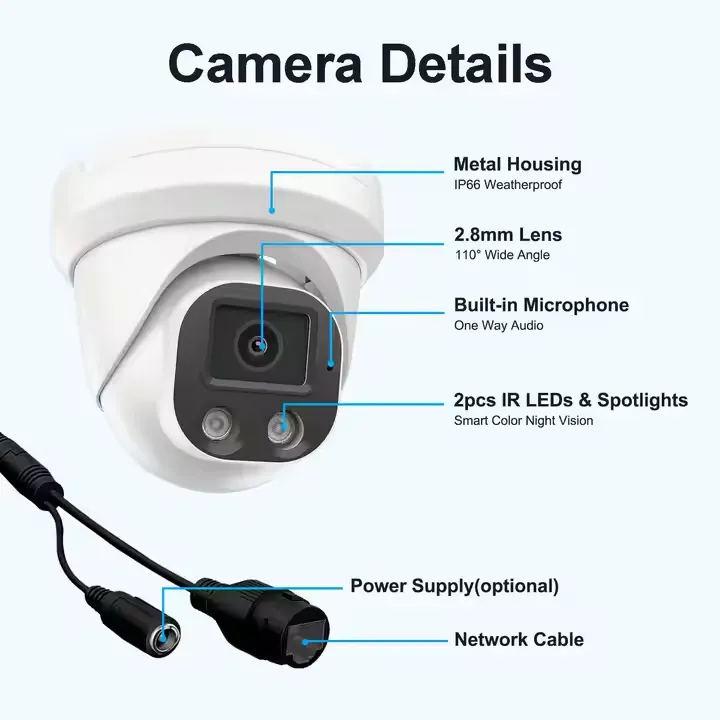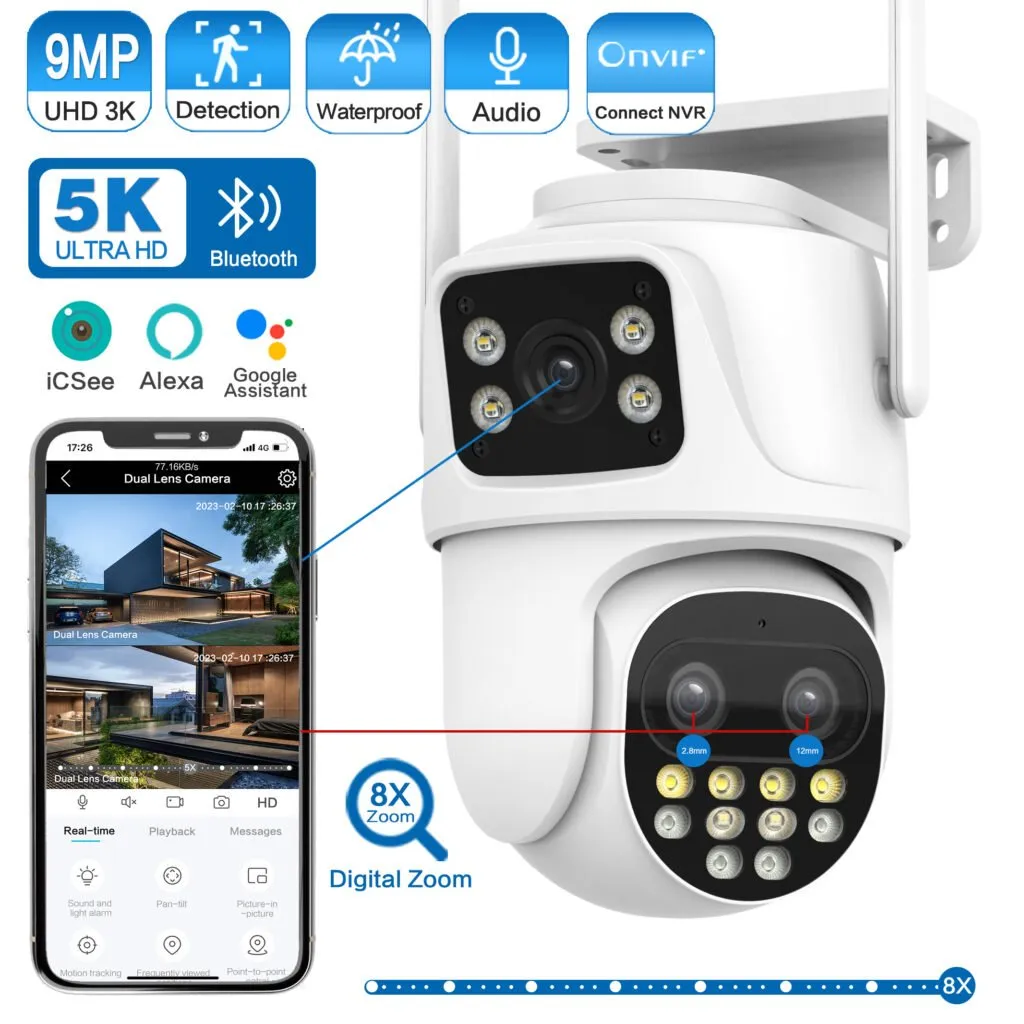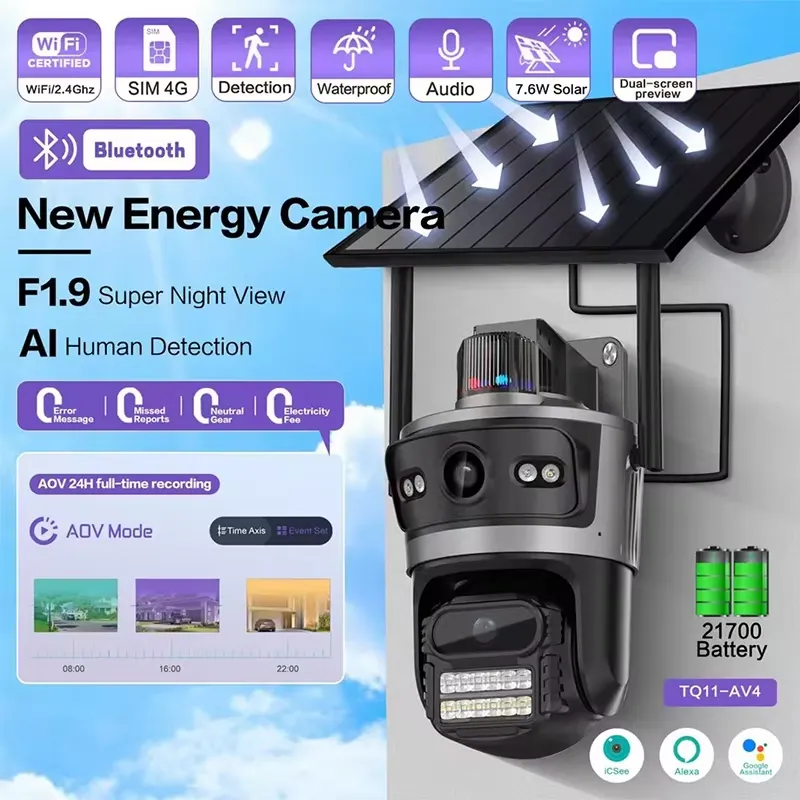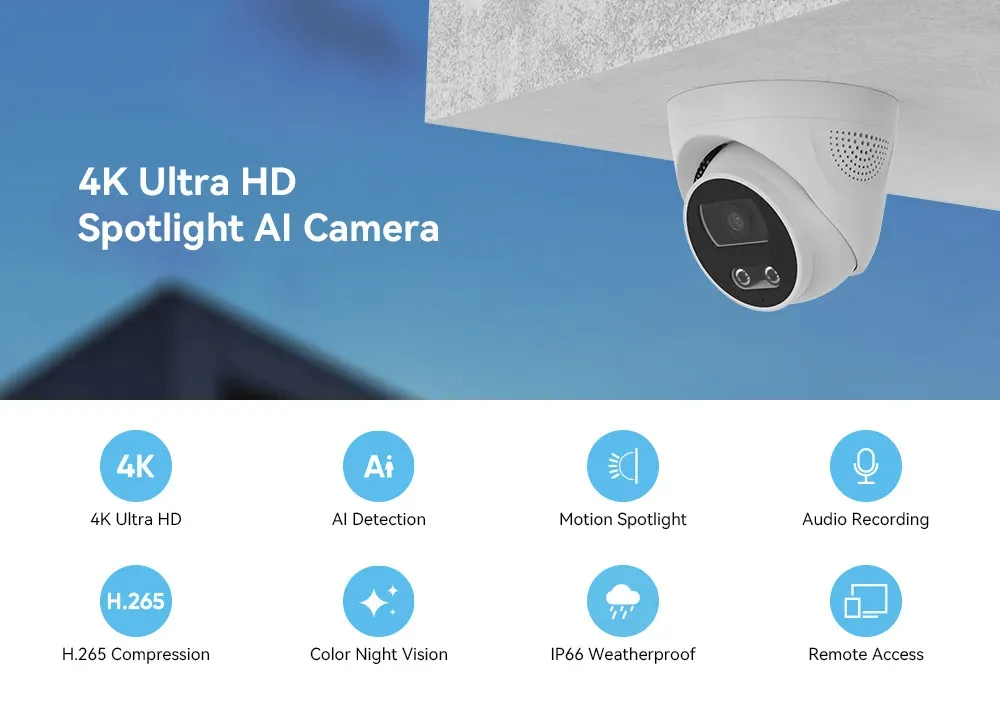A indústria das câmaras de segurança está a registar um crescimento sem precedentes em 2025, com as projecções de mercado a indicarem uma expansão substancial nos próximos anos. Ao avaliar os principais fabricantes mundiais de câmaras de segurança, os principais factores a considerar incluem a quota de mercado, as especialidades tecnológicas e a gama de preços. Como as empresas e os proprietários de casas dão cada vez mais prioridade à segurança, a escolha do fabricante certo nunca foi tão importante. Este guia abrangente ajudá-lo-á a navegar no complexo panorama dos fornecedores de sistemas de câmaras de segurança, desde gigantes da indústria a fabricantes especializados como a JER Technology, permitindo-lhe tomar decisões informadas com base nas suas necessidades de segurança específicas e não apenas no reconhecimento da marca.
Quem são os principais fabricantes de sistemas de câmaras de segurança atualmente?
No panorama em evolução da vigilância de segurança, tenho observado certos fabricantes a ascenderem consistentemente ao topo através da inovação e da fiabilidade. O mercado global de câmaras de segurança em 2024 é dominado por vários intervenientes importantes, cada um deles com vantagens competitivas distintas.
Hikvision
Atualmente, a Hikvision detém a maior quota de mercado global, com uma presença particularmente forte nos mercados asiáticos e uma expansão constante na América do Norte e na Europa. A sua linha de produtos impressiona-me pela sua diversidade - desde sistemas básicos de CCTV a soluções sofisticadas alimentadas por IA que se adaptam a vários desafios de segurança. O que é interessante é a forma como conseguiram manter a qualidade enquanto expandiam as suas operações a nível global.

Comunicações Axis
A Axis Communications, com sede na Suécia, construiu sua reputação como a escolha ideal para implementações de nível empresarial. O seu foco em câmaras de rede de alta qualidade e plataformas de software inovadoras torna-as especialmente valiosas para implementações em grande escala. Achei seu compromisso com a segurança cibernética particularmente notável em um ambiente digital cada vez mais vulnerável.
Tecnologia Dahua
A Dahua Technology segue de perto a Hikvision em termos de quota de mercado, oferecendo capacidades técnicas comparáveis - muitas vezes a preços mais competitivos. Esta relação preço/desempenho ajudou-os a conquistar segmentos de mercado significativos, especialmente em regiões sensíveis ao custo.
Hanwha Techwin
A Hanwha Techwin (anteriormente Samsung Techwin) distingue-se por uma qualidade de imagem excecional que raramente vi ser igualada pelos concorrentes. As suas amplas capacidades de integração com sistemas de terceiros tornam-nos ideais para ecossistemas de segurança complexos em que a interoperabilidade é importante.
Completando os cinco primeiros, a Bosch Security Systems traz para a mesa a lendária fiabilidade da engenharia alemã. As suas capacidades analíticas são particularmente impressionantes em aplicações de alta segurança e proteção de infra-estruturas críticas. Vi os seus sistemas funcionarem sem falhas em ambientes exigentes onde a falha não é uma opção.
| Fabricante | Ponto forte | Aplicação ideal |
|---|---|---|
| Hikvision | Alcance do mercado e gama de produtos | Vigilância geral e integração da IA |
| Comunicações Axis | Fiabilidade de nível empresarial | Instalações empresariais e governamentais |
| Dahua | Rácio custo-desempenho | Implantações de grande dimensão que se preocupam com o orçamento |
| Hanwha Techwin | Qualidade de imagem e integração | Requisitos de grande pormenor e sistemas complexos |
| Bosch | Análise e fiabilidade | Proteção das infra-estruturas críticas |
Tecnologia JER
Para empresas que procuram soluções de segurança à medida, fabricantes especializados de sistemas CCTV como a JER Technology oferecem alternativas a estes grandes actores. A sua abordagem orientada resulta frequentemente em soluções mais personalizadas para as necessidades específicas da indústria.
O cenário continua a evoluir com os avanços tecnológicos. Enquanto a Hikvision e a Dahua dominam em termos de quota de mercado, a Axis, a Hanwha e a Bosch lideram em termos de inovação e fiabilidade empresarial. Para aplicações residenciais, Sistemas de câmaras WiFi tornaram-se cada vez mais populares devido à sua facilidade de instalação e capacidades de monitorização remota.
A escolha do fabricante certo depende, em última análise, dos seus requisitos de segurança específicos, das restrições orçamentais e das necessidades de assistência a longo prazo. Recomendo que avalie não só as ofertas actuais, mas também o roteiro de inovação e a infraestrutura de apoio ao cliente de cada empresa.
Que inovações tecnológicas estão a mudar os sistemas de câmaras de segurança?
Depois de examinar os principais fabricantes, fiquei fascinado com a rapidez com que a tecnologia está a transformar as capacidades das câmaras de segurança. A indústria das câmaras de segurança está a passar por um renascimento da inovação que está a remodelar não só o que estes dispositivos podem fazer, mas também a forma como interagimos com eles.
A inteligência artificial está na vanguarda desta revolução. Como alguém que avalia regularmente sistemas de segurança, vi em primeira mão como as câmaras alimentadas por IA praticamente eliminaram o problema dos falsos alarmes que assolava as gerações anteriores de deteção de movimento. Os sistemas modernos conseguem agora distinguir entre um ramo de árvore a balançar e um intruso real - uma distinção aparentemente simples que anteriormente gerava inúmeros alertas incómodos.

As capacidades de aprendizagem automática levaram esta inteligência ainda mais longe, permitindo sistemas que melhoram com o tempo. Estou particularmente impressionado com os avanços no reconhecimento facial que permitem a identificação de pessoas autorizadas, ao mesmo tempo que assinalam indivíduos desconhecidos. Esses sistemas podem até detetar comportamentos incomuns, como vadiagem ou cenários de roubo de pacotes, fornecendo segurança proativa em vez de reativa.
A integração do armazenamento em nuvem mudou fundamentalmente a forma como as filmagens de segurança são geridas. Lembra-se dos dias em que se substituíam as cassetes DVR ou se perdiam filmagens críticas devido a falhas de hardware? Hoje em dia, os Sistemas de câmaras WiFi fazem automaticamente cópias de segurança para servidores seguros na nuvem, tornando as filmagens acessíveis a partir de qualquer lugar e melhorando drasticamente a fiabilidade.
| Inovação tecnológica | Benefício primário | Desafio de implementação |
|---|---|---|
| Inteligência Artificial | 95% redução de falsos alarmes | Requisitos de potência de processamento |
| Integração na nuvem | Acesso remoto e maior fiabilidade | Consumo de largura de banda |
| Conectividade IoT | Respostas de segurança automatizadas | Vulnerabilidades de cibersegurança |
| Resolução 4K/8K | Identificação a distâncias maiores | Requisitos de armazenamento |
A integração com estruturas IoT foi talvez a mudança mais transformadora que observei. As câmaras de segurança modernas já não funcionam de forma isolada - comunicam com fechaduras inteligentes, sistemas de iluminação e até controlos de AVAC. Recentemente, instalei um sistema que ilumina automaticamente as luzes exteriores e envia alertas para o smartphone no momento em que alguém se aproxima da propriedade fora de horas.
Alguns Fabricantes de sistemas CCTV como a JER Technology desenvolveram algoritmos proprietários que oferecem estas capacidades de nível empresarial a preços surpreendentemente acessíveis. Os seus sistemas de reconhecimento orientados por IA podem identificar indivíduos específicos, mantendo simultaneamente uma proteção razoável da privacidade - um equilíbrio delicado no atual panorama de segurança.
O que mais me impressiona é a forma como estas tecnologias se complementam. As capacidades da nuvem tornam o processamento da IA mais potente, tirando partido dos recursos de computação remota, enquanto a integração da IoT torna a deteção inteligente mais útil, desencadeando automaticamente as acções adequadas.
Para as empresas que estão a considerar atualizar o sistema de segurança, estes avanços tecnológicos não melhoram apenas a segurança - criam eficiências operacionais que podem proporcionar um ROI significativo para além da proteção básica. A câmara de segurança moderna evoluiu de um simples dispositivo de gravação para um nó inteligente num ecossistema de segurança abrangente.
Estas inovações continuam a remodelar o panorama competitivo entre os fabricantes, à medida que avançamos para sistemas de segurança cada vez mais inteligentes e interligados.
Como é que as preferências dos mercados regionais afectam o sucesso do fabricante?
Tendo explorado as inovações tecnológicas que fazem avançar a indústria, observei como as preferências regionais moldam drasticamente o sucesso dos fabricantes no mercado global de câmaras de segurança. O que funciona em Tóquio muitas vezes não se traduz em Toronto ou Turim - uma realidade que os fabricantes inteligentes aprenderam a aceitar em vez de combater.
Na América do Norte, notei uma preferência distinta por fabricantes com fortes credenciais de cibersegurança e conformidade com a NDAA. Este requisito regulamentar beneficiou significativamente empresas como a Axis Communications e a Hanwha Techwin, ao mesmo tempo que criou desafios de acesso ao mercado para alguns fabricantes chineses. As empresas americanas valorizam particularmente as soluções que protegem não só os activos físicos, mas também os digitais - uma mentalidade de dupla segurança que molda as decisões de compra.

Os mercados europeus apresentam um cenário totalmente diferente, dominado pelas considerações do RGPD. Ajudei clientes a navegar nestas águas, onde o design centrado na privacidade não é apenas preferido - é legalmente exigido. Os fabricantes que têm sucesso aqui adoptaram princípios como a privacidade desde a conceção, a recolha mínima de dados e práticas de processamento transparentes. A ênfase na proteção de dados cria oportunidades naturais para as empresas que integram estes valores nos seus produtos desde a conceção e não como reflexões posteriores.
A região da Ásia-Pacífico representa a maior fronteira de crescimento do sector, com variações regionais fascinantes. Os fabricantes sediados na China, como a Hikvision e a Dahua, mantêm posições de liderança a nível nacional, enquanto se expandem agressivamente a nível global. O Japão tende a favorecer soluções de alta precisão e fiabilidade, enquanto os mercados emergentes do Sudeste Asiático dão frequentemente prioridade à relação custo-eficácia equilibrada com funcionalidades modernas.
| Região | Principal fator de mercado | Impacto regulamentar | Principais fabricantes |
|---|---|---|---|
| América do Norte | Cibersegurança e conformidade | Elevado (NDAA) | Axis, Hanwha, Bosch |
| Europa | Proteção da privacidade | Muito elevado (RGPD) | Bosch, Axis, Tecnologia JER |
| Ásia-Pacífico | Custo vs. funcionalidade | Variável por país | Hikvision, Dahua, Especialistas locais |
| Médio Oriente | Durabilidade ambiental | Moderado | Bosch, Hanwha, JER Technology |
As realidades da infraestrutura criam outra camada de diferenciação regional. Implementei projectos em regiões com conetividade pouco fiável, onde as soluções de gravação baseadas na periferia superam drasticamente os sistemas dependentes da nuvem. Os projectos mais bem sucedidos Fabricantes de sistemas CCTV adaptar as arquitecturas dos seus produtos a estas diferentes capacidades de infraestrutura, em vez de assumirem uma conetividade universal de alta velocidade.
Empresas como Tecnologia JER obtiveram sucesso através de variantes de produtos específicos para cada região. A sua abordagem de criação de plataformas de base adaptáveis que podem ser personalizadas de acordo com os requisitos regionais permitiu o acesso ao mercado em dezenas de países, apesar dos diferentes quadros regulamentares. Esta flexibilidade revelou-se particularmente valiosa nos mercados emergentes, onde a sensibilidade ao preço tem de ser equilibrada com funcionalidades avançadas.
Para as empresas que operam em várias regiões, compreender estas variações regionais não é apenas interessante - é essencial para um planeamento de segurança eficaz. As Sistemas de câmaras WiFi que funcionam na perfeição nas suas operações nacionais podem deparar-se com obstáculos regulamentares ou limitações práticas quando implantadas a nível internacional.
O impacto da conformidade regional na quota de mercado não pode ser exagerado - já vi alguns fabricantes serem efetivamente excluídos de mercados específicos, apesar das suas capacidades técnicas superiores, simplesmente devido a restrições regulamentares. Esta realidade cria desafios e oportunidades para os fabricantes de câmaras de segurança que pretendem expandir a sua presença global.
Porque é que as empresas devem considerar fabricantes especializados como a JER Technology?
Tendo navegado pelas complexas variações regionais nos mercados de câmaras de segurança, observei uma tendência crescente entre as empresas mais experientes: afastarem-se dos gigantes da indústria em direção a fabricantes especializados para as suas necessidades de segurança. Embora os grandes nomes dominem certamente as estatísticas de quotas de mercado, muitas vezes ficam aquém quando entram em cena requisitos únicos.
Já trabalhei com empresas de todos os sectores que inicialmente abordaram grandes fabricantes, mas que se viram forçadas a soluções padronizadas que quase - mas não totalmente - satisfaziam as suas necessidades específicas. É precisamente aqui que os fabricantes especializados como a Tecnologia JER criar a sua vantagem competitiva.

Fundada em 2009, a JER Technology ganhou rapidamente reconhecimento por enfrentar os desafios de segurança que os grandes fabricantes normalmente consideram demasiado específicos ou de pequena escala para acomodar. A sua gama de produtos abrange câmaras IP de elevado desempenho e sistemas WiFi de lente dupla adaptados a aplicações industriais específicas.
As capacidades de personalização distinguem verdadeiramente os fabricantes especializados. Recentemente, prestei consultoria num projeto em que um cliente necessitava de câmaras que resistissem a uma exposição extrema a produtos químicos num ambiente de fabrico. Os principais fabricantes ofereciam apenas a proteção IP66 padrão, que teria falhado em poucos meses. A JER forneceu caixas modificadas com revestimentos especializados por uma fração do que a engenharia personalizada teria custado noutro local.
| Tipo de personalização | Principais fabricantes | Tecnologia JER |
|---|---|---|
| Modificação do firmware | Mínimo de 500 unidades | Disponível a partir de 25 unidades |
| Alojamento personalizado | Mínimo de 1000 unidades | Disponível a partir de 30 unidades |
| Algoritmo de reconhecimento | Apenas contratos empresariais | Disponível para todos os clientes |
| Acesso direto à engenharia | Raramente disponível | Norma para todas as implementações |
Um estudo de caso particularmente impressionante envolveu uma empresa agrícola europeia que se debatia com a perda de colheitas. As câmaras de monitorização ambiental personalizadas da JER com algoritmos de reconhecimento especializados reduziram as suas perdas em 37% através da deteção precoce de pragas - uma solução que nenhum grande fabricante teria desenvolvido para a sua relativamente pequena instalação de 50 câmaras.
A experiência de implementação também difere drasticamente. Com os principais fabricantes, é normalmente entregue a parceiros de integração assim que as ordens de compra são assinadas. Descobri que fabricantes especializados de sistemas CCTV como o JER fornecem acesso direto às equipas de engenharia ao longo de todo o processo, resultando em taxas de implementação mais elevadas e bem sucedidas.
Os ganhos de eficiência podem ser substanciais - normalmente uma melhoria de 15-25%, evitando os compromissos necessários com sistemas padronizados. Para empresas com desafios de segurança específicos, isto traduz-se num menor número de câmaras que obtêm melhores resultados através de uma colocação precisa e de uma funcionalidade personalizada.
É claro que os fabricantes especializados não são a escolha certa para todos os cenários. Se precisar de milhares de câmaras básicas implementadas em ambientes padronizados, as economias de escala dos principais fabricantes fazem sentido. Mas para empresas com desafios específicos ou ambientes únicos, a flexibilidade e a experiência concentrada de fabricantes especializados, como a JER Technology, geralmente oferecem resultados superiores e melhor valor a longo prazo.
Para obter informações diretas sobre sistemas de câmaras de segurança especializados, pode contactar JER Technology para discutir os seus requisitos específicos com a sua equipa de engenharia.
Que tendências futuras irão moldar o fabrico de câmaras de segurança?
A integração 5G destaca-se como talvez a mudança de jogo mais significativa no horizonte. Testei as primeiras câmaras ligadas a 5G e a diferença é notável - eliminando praticamente as restrições de largura de banda que historicamente limitaram as opções de implementação remota. Esta tecnologia permite instalações verdadeiramente sem fios em locais que anteriormente exigiam modificações dispendiosas da infraestrutura, ao mesmo tempo que suporta fluxos de maior resolução que captam detalhes críticos.
Depois de analisar os principais fabricantes e os intervenientes especializados, como a JER Technology, estou particularmente entusiasmado com as tendências transformadoras que se preparam para remodelar o fabrico de câmaras de segurança nos próximos 3-5 anos. Estas tecnologias emergentes e mudanças regulamentares irão criar desafios e oportunidades para as empresas que selecionam soluções de vigilância.

As capacidades de IA da próxima geração irão redefinir fundamentalmente o que as câmaras de segurança podem detetar. A geração atual identifica actividades básicas, mas os sistemas futuros compreenderão o contexto, distinguindo entre comportamento normal e potenciais ameaças com base em padrões e não em simples accionadores de movimento. Esta consciência contextual promete eliminar virtualmente os falsos alarmes e aumentar a deteção de incidentes de segurança genuínos.
| Tecnologias emergentes | Aplicação atual | Projeção futura (2026) |
|---|---|---|
| Conectividade 5G | Programas-piloto limitados | ~40% de novas instalações |
| Capacidades de IA | Reconhecimento básico de objectos | Previsão do estado emocional e do comportamento |
| Processamento de bordas | Apenas análise simples | Reconhecimento complexo sem dependência da nuvem |
| Caraterísticas de privacidade | Encriptação opcional | Anonimização obrigatória e controlos de dados |
Os regulamentos sobre privacidade continuam a ser mais rigorosos a nível mundial, criando requisitos de conformidade complexos para os fabricantes. Prevejo restrições significativas às tecnologias de reconhecimento facial, juntamente com regras mais rigorosas de armazenamento e processamento de dados. Líderes Fabricantes de sistemas CCTV já estão a desenvolver plataformas mais flexíveis que se podem adaptar a requisitos regionais variáveis através de actualizações de software em vez de substituições de hardware.
A cibersegurança tornar-se-á um fator de diferenciação cada vez mais crítico, uma vez que as câmaras ligadas continuam a ser potenciais pontos de vulnerabilidade na infraestrutura de rede. Os protocolos de segurança rudimentares das câmaras da geração anterior simplesmente não serão suficientes contra ameaças sofisticadas que visam dispositivos IoT. A encriptação avançada, os processos de arranque seguros e a deteção automática de ameaças estão a tornar-se requisitos padrão em vez de caraterísticas premium.
Tecnologia JER parece estar particularmente bem posicionada entre os fabricantes especializados, graças aos seus investimentos no processamento de IA baseado em bordas. Esta abordagem reduz as preocupações com a privacidade, analisando o vídeo localmente em vez de transmitir tudo para servidores na nuvem, mantendo capacidades de reconhecimento avançadas e minimizando os riscos de exposição de dados.
Para as empresas que planeiam investimentos em sistemas de segurança, estas tendências sugerem a adoção de soluções modulares que possam incorporar tecnologias emergentes sem substituições completas. Sistemas de câmaras WiFi com vias de atualização de firmware oferecem uma maior longevidade do que as arquitecturas fechadas, podendo poupar custos de substituição significativos à medida que as tecnologias evoluem.
Recomendo que as organizações avaliem não só as capacidades actuais, mas também os roteiros de inovação e as políticas de atualização dos fabricantes. Os interessados em preparar os seus investimentos em segurança para o futuro devem contactar fabricantes especializados para discutir os roteiros tecnológicos e as garantias de compatibilidade antes de se comprometerem com grandes implantações de sistemas.

Conclusões
Ao avaliar os fabricantes de sistemas de câmaras de segurança em 2024, o panorama vai muito além da simples comparação de marcas. A escolha ideal depende de requisitos de segurança específicos, ambientes de implementação, restrições orçamentais e objectivos a longo prazo. Enquanto líderes do setor como Hikvision e Axis Communications oferecem registros comprovados e extensos ecossistemas de produtos, fabricantes especializados como a JER Technology oferecem vantagens por meio de personalização, suporte dedicado e soluções inovadoras adaptadas a casos de uso específicos. À medida que inovações tecnológicas como IA, conetividade em nuvem e 5G continuam a remodelar esse setor, os fabricantes que se adaptam com sucesso à evolução tecnológica e regulatória, ao mesmo tempo em que abordam os desafios de segurança do mundo real, acabarão por oferecer o maior valor. Quer a sua prioridade seja a implementação à escala empresarial, a análise de ponta, a fiabilidade que se preocupa com o orçamento ou a personalização especializada, compreender as vantagens distintas dos diferentes fabricantes de câmaras de segurança é essencial para implementar soluções de segurança verdadeiramente eficazes.


